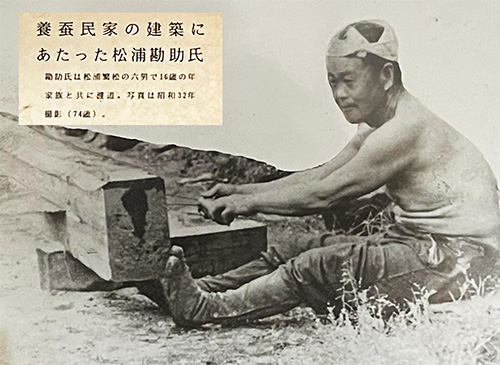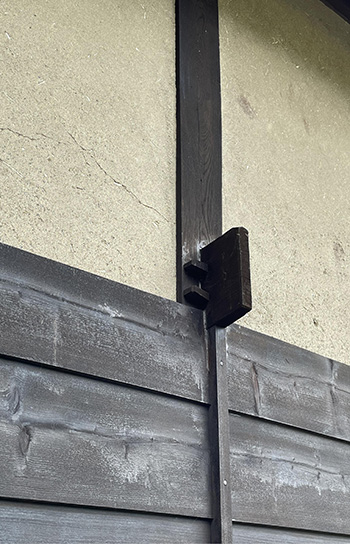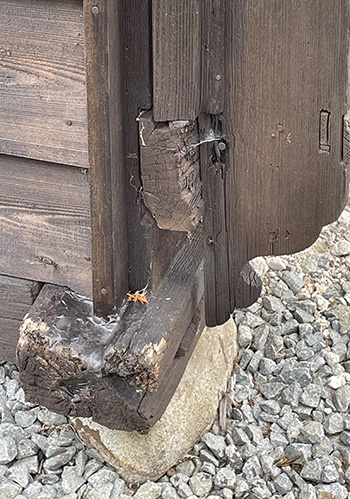

福島県大田村・現在の伊達市から1899年(明治31年)に集団移住した人々。
移住団長・菊田熊之助氏が移住の「米飯地区」に野桑が繁茂している様子を見て
団員に養蚕を奨励したとされる。
そもそもが大田村は養蚕が盛んだったという。
北海道庁との集団移住話合いの中で、そうした「好適地」が推奨され、
その事業目的が優勢でこの地を選択したものと思える。
集団移住者のなかにこの養蚕民家の建て主・松浦繁松氏がいた。
下の写真は当主・繁松氏の6男、勘助氏。移住当時16才だったという。
撮影写真は昭和32年で74才当時のものだというが、
養蚕の百姓(あらゆる仕事を自力で行う、という意味)らしく
建築工事を精力的に行っている。これで74才とはなんとも若々しい。
凛々しい鉢巻き姿には克己心が表出しているように思う。
昔の人はそもそも鍛え方がハンパではない。
養蚕は蚕自体の生態の把握、その最適化に努める必要があるのはもちろん、
そのためには「建築環境・室内気候環境」保全に繊細な技術が不可欠。
この写真の様子からはそれこそ養蚕にかかわるすべての作業、
とくに建築作事についても大工任せにしない気概を感じる。
蚕の成育状況、その製品品質に建築は直結していたことから、
つねに工事で「手を入れて」いたに間違いない。
「もうちょっと暖房の効率を良くするには、屋根の萱を増やすか・・・」
「2階の開口部からの日射導入をもっと増やすべきか」
など、それこそ製造工場維持管理のように大工仕事に当たっていたと想像。



氏の事跡を伝える情報は不明だけれど、
たぶん農閑期には出稼ぎで大工手間仕事を行っていたに違いない。
近在の都市、旭川で棟梁に指揮される大工仕事から
見よう見まねで大工技術をウォッチして体得したことだろう。
その技量向上がそのまま自分の養蚕業稼ぎの生産性向上に直結する。
復元された養蚕民家のディテールには武骨ながら
丹精が込められていると伝わってくるモノがある。
開拓期の北海道では全国から集まってきたそういう人々の熱気が
渦巻いていたことが想像される。空気感が熱い。
余談ながら、わが家家系でも祖父は1905年(明治38年)に広島県福山から
出身地の縁者を頼って北海道栗沢町に一家を挙げて移住した。
もともと家業は商家だったことから新天地でのチャレンジに積極的で、
この松浦氏同様、周辺での豊富な野桑の繁茂ぶりを見て
養蚕にも手を出していたという。
しかし養蚕業の技術蓄積は十分ではなくそれは断念した。
この時代、さまざまな場所で必死の挑戦が果敢に行われていたのだろう。
祖先の息づかい、時代の空気感がこの養蚕民家から立ち上ってくる。
素晴らしい開拓者魂がこの建築には込められている。
松浦さんの表情に迷いは一点も感じられない。
翻って現代、自分自身を省みて深く教えられるものがある。・・・
English version⬇
Transplanting sericultural construction techniques from Fukushima to Hokkaido.
Management and operation of sericultural private houses, including carpentry and construction. The goal of indoor climate control technology. Ingenuity and ingenuity while utilizing traditional construction methods. The building is a pioneer building.
A group of people emigrated from Ota Village, Fukushima Prefecture, now Date City, in 1899 (Meiji 31).
It is said that Kumanosuke Kikuta, the leader of the emigration group, saw wild mulberry trees thriving in the “Yonei area” of the emigration
He is said to have encouraged the members of the group to grow silkworms.
Sericulture was said to have flourished in Ota Village in the first place.
In the group emigration discussions with the Hokkaido Government, such a “suitable site” was recommended, and
It is likely that this site was selected because of the predominance of the business objectives.
Among the emigrants was Shigematsu Matsuura, the builder of this silkworm-raising house.
The photo below shows Shigematsu’s sixth son, Kansuke. He was 16 years old at the time of emigration.
The photo was taken in 1957, when he was 74 years old.
He is a sericultural peasant (meaning that he does all kinds of work on his own).
He was energetically engaged in construction work. He was 74 years old, which is very young.
His dignified appearance in a padded kimono seems to express his self-sacrificing spirit.
People in the olden days were not so hardy in the way they worked out in the first place.
Sericulture requires an understanding of the ecology of the silkworms themselves and efforts to optimize it.
For this purpose, delicate techniques are indispensable in preserving the “architectural environment and indoor climate environment.
From this picture, it is clear that all the work involved in sericulture, especially the construction work, is entrusted to a great extent.
The picture shows that the silkworm farmers do not leave all the work related to sericulture, especially the construction work, to the carpenters.
The construction work was directly related to the growth of silkworms and the quality of their products.
The construction of the silkworm farms was directly related to the growth of silkworms and the quality of their products, so it is certain that the workers were always “tending” to the construction.
The building was always being “worked on.” “To make the heating a little more efficient, we should increase the amount of roofing shade…” “The daylight from the second-floor opening should be more efficient,” said the owner.
“Should we increase the amount of sunlight coming in through the second-floor openings?
I imagine that they were doing carpentry work as if they were maintaining a manufacturing plant.
Although there is no information on his whereabouts, he must have worked as a migrant carpenter during the off-season.
He must have worked as a migrant carpenter during the off-season.
He probably learned his carpentry skills by watching and learning from the master carpenters in Asahikawa, a nearby city, and by watching and learning from them.
He must have learned carpentry skills by watching and learning from the master carpenters in Asahikawa, a nearby city.
The improvement of his skills directly leads to the improvement of his own productivity in the sericultural industry.
The details of the restored silkworm farm houses, though rugged, are conveyed with great care.
The restored silkworm-raising houses, while rugged in appearance, convey the sense that a great deal of care and diligence went into their construction.
In Hokkaido during the pioneer period, the enthusiasm of people from all over the country was swirling in the air.
Hokkaido during the pioneer period. The atmosphere was hot.
As a side note, in my family, my grandfather came from Fukuyama, Hiroshima Prefecture in 1905.
He and his family moved to the town of Kurisawa in Hokkaido, Japan, with the help of relatives from his hometown.
Originally, the family business was a merchant family, and they were eager to take on the challenges of a new land.
Like Mr. Matsuura, he saw the abundance of wild mulberry trees in the area and took up sericulture.
The family was originally a merchant family and was willing to take on new challenges in new places.
However, he gave up sericulture because he had not accumulated enough technology.
In this period, desperate attempts must have been made boldly in various places.
The breath of the ancestors and the atmosphere of the times rise up from this sericultural house.
The wonderful pioneer spirit is contained in this architecture.
There is not a trace of hesitation in Mr. Matsuura’s expression.
In retrospect, I am deeply impressed by the way he reflects on his own life today. The building is a pioneer building.
Posted on 9月 15th, 2022 by 三木 奎吾
Filed under: 住宅マーケティング, 古民家シリーズ







コメントを投稿
「※誹謗中傷や、悪意のある書き込み、営利目的などのコメントを防ぐために、投稿された全てのコメントは一時的に保留されますのでご了承ください。」
You must be logged in to post a comment.